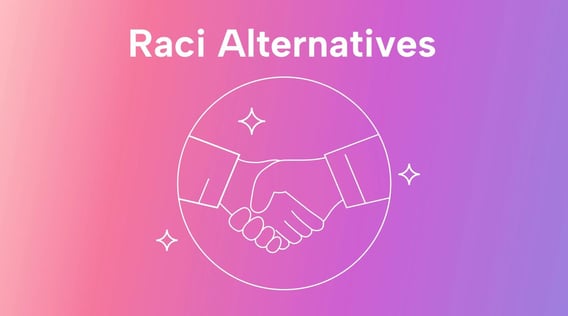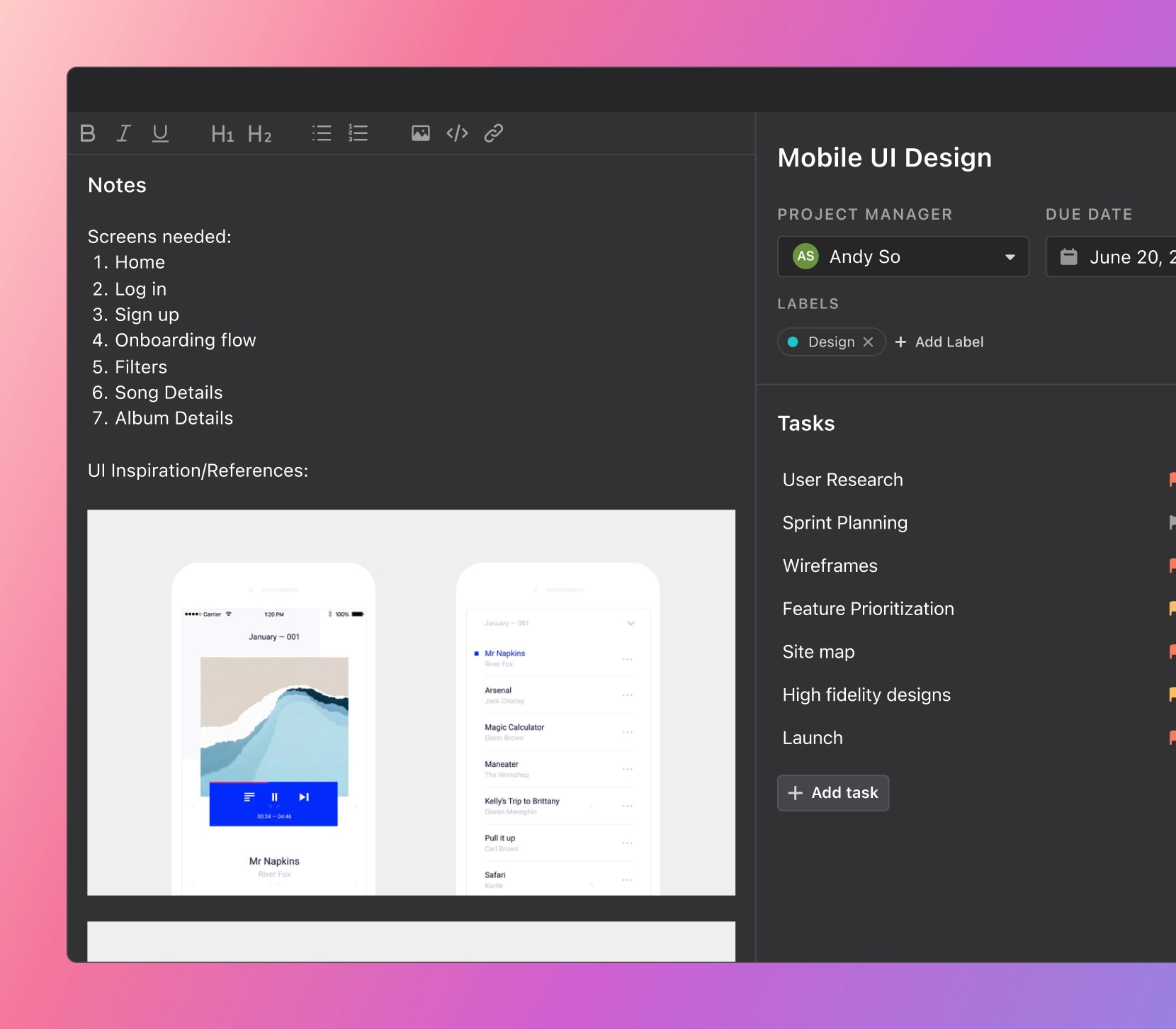Teams. Can’t live with them. Can’t live without them.
Just as the family is the most important unit of a society, the most important unit of an organization is a team, not the individual.
At the end of the day, individuals make teams possible, of course. However, how much can someone accomplish without help or guidance? Not much.
“My model for business is The Beatles. They balanced each other, and the total was greater than the sum of the parts. That's how I see business: great things in business are never done by one person; they're done by a team of people.” Steve Jobs
We created the wheel, domesticated fire, and launched a rocket to the moon together. But anyone who's tried to get a group of people to work together knows it can be a nightmare.
Assigning responsibilities correctly is a great headstart to build a team you can trust.
Methods like the RACI matrix have been developed to get as much strain as possible off your shoulders.
However, during the last decades, many more models have been created to fill the holes RACI doesn’t cover.
In this article, we’ll dive into these alternatives’ advantages and disadvantages and how they can help you create a better team culture.
Why is it important to set clear responsibilities?
Ideas take on a life of their own. When communicated poorly, they manifest in various forms in the minds of different individuals. And even small mistakes can have consequences.
A 2022 study conducted by the Harris Poll revealed miscommunication costs US businesses $12,506 per employee per year.
Consequently, setting clear guidelines for what you expect from everyone’s roles has its benefits.
Another recent study showed the perks of role clarity. The study reported increased satisfaction by 16%, engagement by 17%, performance by 24%, and efficiency by 53%.
Because of its apparent benefits, responsibility charts like RACI exist.
What is RACI, and why does it fail?
RACI charts have one purpose. They pave the most efficient way to take a project from beginning to success by tackling confusion over accountability.
Each character represents the following roles: Responsible (carries out the task and completes the work), Accountable (takes ownership of the task, deliverable, or project's success and has final approval), Consulted (provides specialized advice or input), and Informed (receives updates or results through one-way communication).
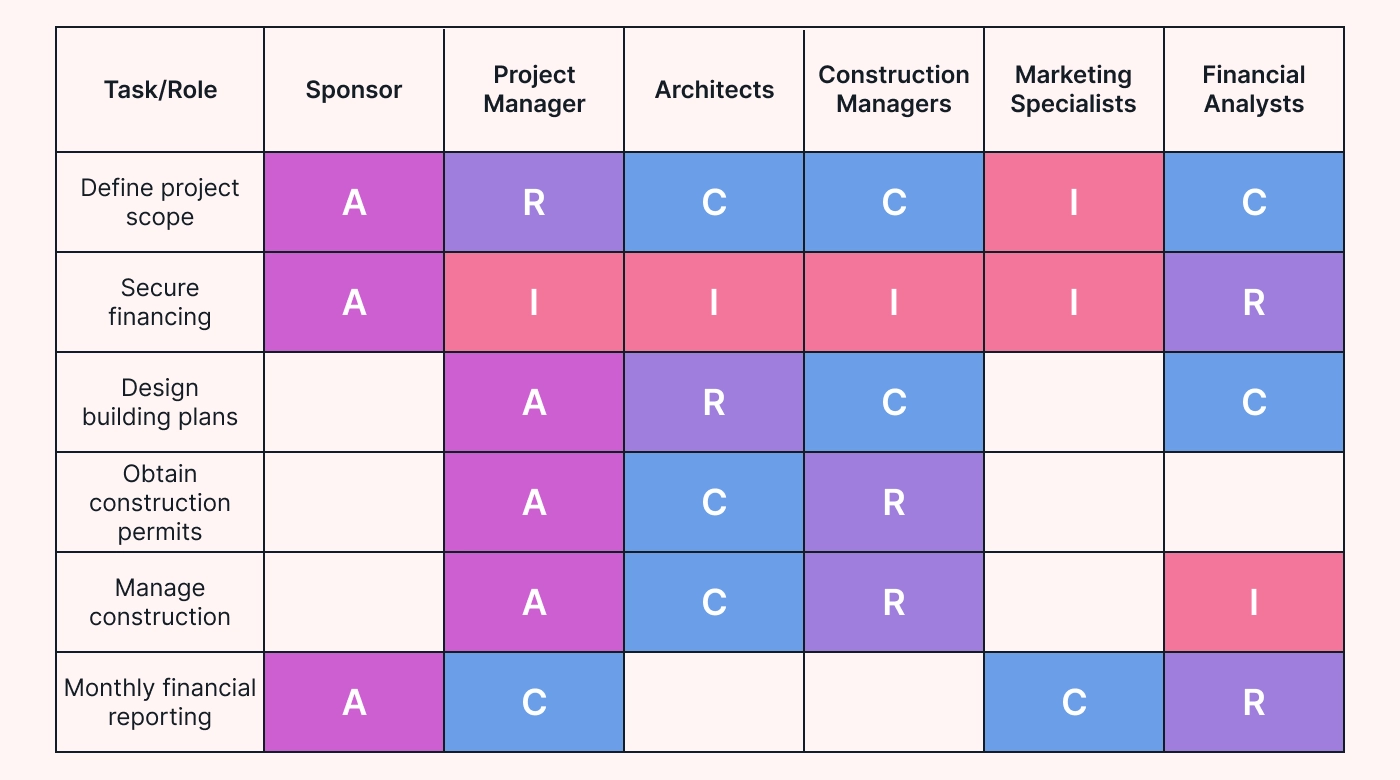 |
It sets a clear communication plan through expectations about who's responsible for what task and to what extent and in what way someone is involved in each task of the process.
The RACI chart above ensures key stakeholders understand their roles and responsibilities clearly. It minimizes confusion and clarifies who needs to be involved or informed at each project stage.
In the first row, you’ll see the sponsor as accountable for defining the project scope. However, the project manager, as the responsible person, is the one who works on the task. Architects, construction managers, and financial analysts give input without acquiring responsibility for the task. And finally, marketing specialists are informed about the result.
However, RACI tends to have more than one disadvantage during its application.
- As it is best used in specific-result projects, it doesn’t reflect who decides because the decisions aren’t going to change.
- The terms can be confusing when not properly specified or in small teams. This happens because one person might end up in more than one role, or those who do the work and those who account for its results might get confused.
- You might struggle to fit your company’s or project’s roles into only four categories (R-A-C-I).
Precisely for those reasons, other similar methods and charts were developed. They all try to find the ideal way to clarify individual activities and the level of responsibility each member has over them. Although each method has a different acronym, they all fall into two categories: task-driven and decision-driven.
Task-driven alternatives: RASCI, PACSI, and ARPA
Clear role assignments and communication are cornerstones of collaboration and teamwork.
Almost every task-driven alternative is either trying to solve term-related confusion or adding another role for support with different levels of responsibility over a task.
Here are some of the most popular RACI alternatives.
What is RASCI?
This responsibility assignment matrix adds an “S” to RACI, which stands for Support. The “support” role represents those who provide assistance in the execution of a given task without leading it or acquiring ultimate responsibility for its completion.
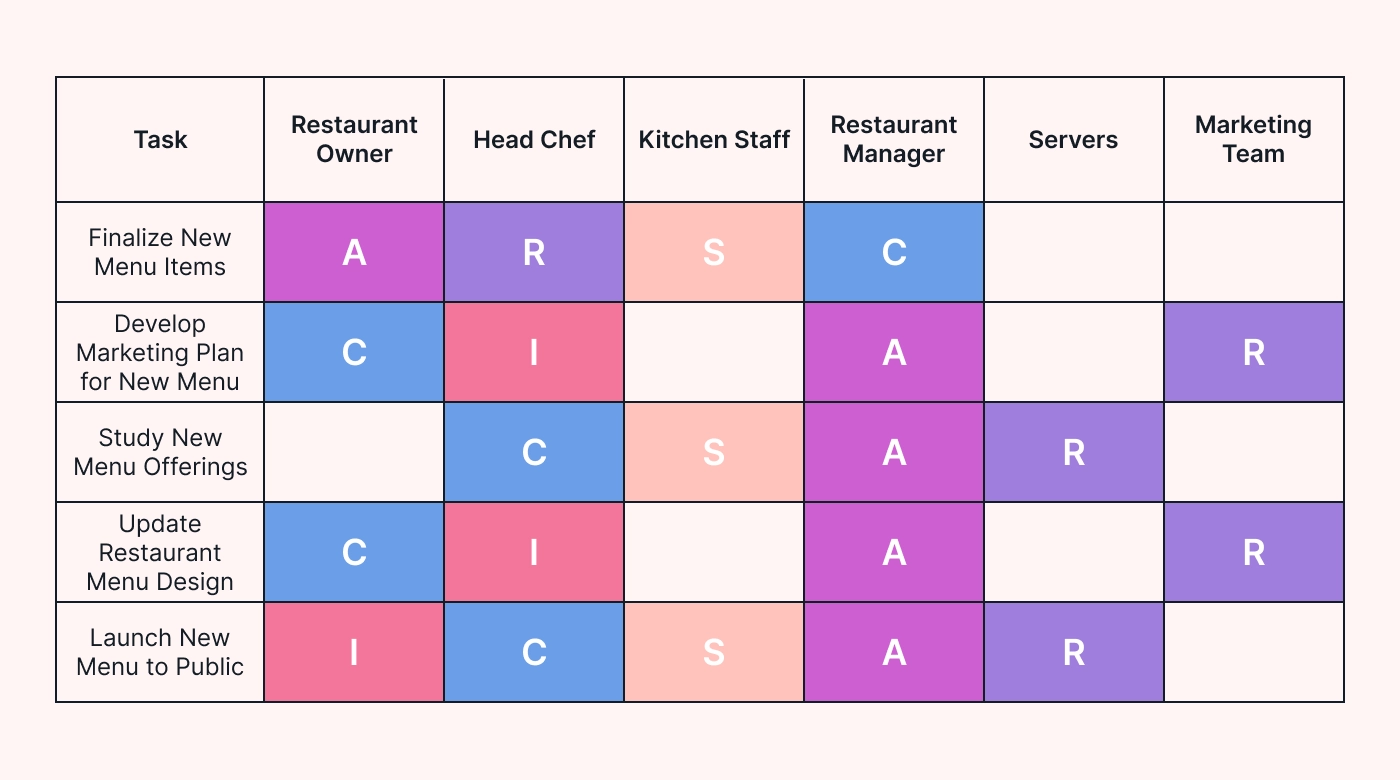 |
For example, in a project to launch a new menu for a restaurant, the kitchen staff provides additional support in different tasks. However, they don’t acquire ultimate responsibility.
As this method is firmly based on RACI, it also carries the same disadvantages. Leaving no space for decision-makers is probably the most notable one. However, the benefits of RASCI lie in the added “S.”
This method recognizes the value Supporters give, even though they aren’t directly responsible for the results. Ultimately, they are a valuable resource that helps get things done, incurs costs and utilizes the Supporters' time.
What does PACSI mean?
PACSI is a tool for responsibility planning. It defines the stakeholder roles as follows: Perform (carries out the activity), Accountable (answers for the thorough completion of the task), Control (reviews activity’s result and has a right of veto), Suggest (gives expert advice), and Informed (is informed about the activity’s result).
So, for a deliverable, the expert might perform the work, the project manager would be accountable, and the client would control or have right to accept or reject the deliverable.
This method’s key differentiator lies in its distinction between the roles of Perform and Accountable. Such a distinction makes it easier for a team to understand each other’s responsibilities.
Also, PACSI establishes a system in which various stakeholders can review and reject the actions of a single individual who’s ultimately responsible (through the Control role).
In contrast to the previous two task-driven methods, PACSI clearly distinguishes between the person accountable for delivering the task and the one who reviews the quality of the results.
How does ARPA work?
Even though this method is also task-driven, it’s made for projects that struggle to find consensus among team members.
ARPA’s main differences are two. It redefines roles’ names to improve clarity and introduces one decision-making role. Such a role is signaled by the first letter “A” of the acronym. Accountable is the role responsible for the project or business performance and takes strategic decisions.
The Responsible role ensures the project gets done within project constraints while Participants are essential resources (like skills, time and money) to support the task’s or project’s success.
People under the role of Advisor give expert opinion to guide a task, project, or business. However, they don’t have any authority in decision-making.
In contrast to other task-driven alternatives, this method introduces decision power as part of the process of a project. But a decision is not the focus of the Responsible role – it just might happen that some decisions must be made along the way.
This model is especially helpful for executives or a sponsor to know how involved they are in a project and which decisions they can take, if any.
Decision-driven alternatives: RAPID and DACI
Now, if you’re dealing with ambiguity in decision roles, then the following alternatives might be what you’re looking for. Decisions are the central issue in these models, in addition to who gets the work done.
How does RAPID work?
RAPID is a decision-making framework that sets decision accountability across teams. It stands for Recommend (analyzes information and recommends actions), Agree (must agree to the recommendation before it proceeds), Perform (implements the decision), Input (provides expertise or data to inform the recommendation), and Decide (makes the final decision).
Even though it’s commonly known as RAPID, the correct progression of decisions would form IRADP. This happens because you need expert input first. Then, analyze such input to provide a recommendation. After that, agree, decide, and finally perform the implementations.
RAPID differs from the RACI model as a decision-making process because it manages decision makers (who has which role in which decisions).
For example, if you have a national or international business, who has the decision authority for which price in which regions? Is it HQ or regional management? Likewise, who decides on packaging? In such cases, a RAPID chart or a decision-making matrix comes in handy.
Smaller businesses also benefit from clarity in decisions. For example, a marketing agency working on a national campaign launch for a client – people in the agency might perform the work, but would need to know who can make which kinds of decisions for the campaign.
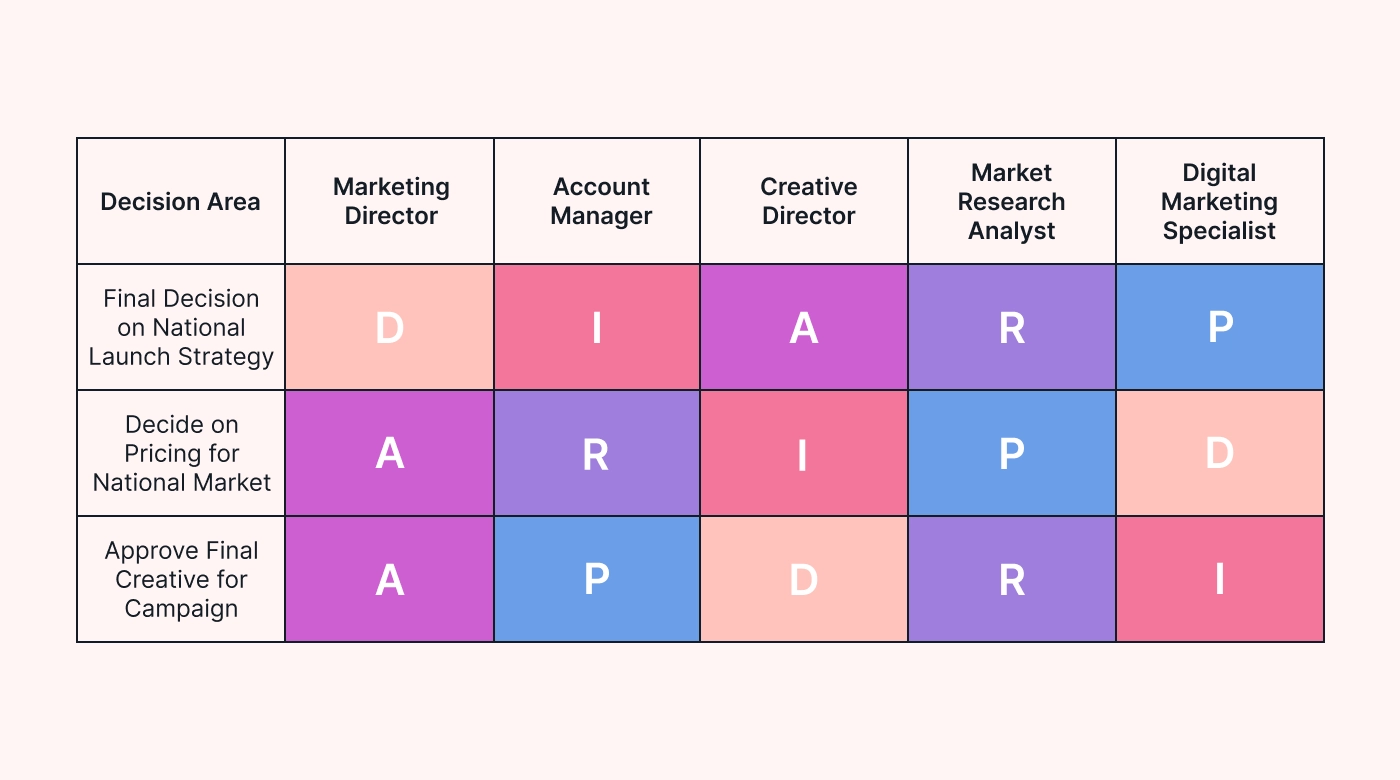 |
The first row shows how the Account Manager (I) provides client feedback while the Market Research Analyst (R) recommends strategies based on national data. Then, the Creative Director (A) agrees with the strategy alignment with the creative content, allowing the Marketing Director (D) to make the final decision. Finally, the Digital Marketing Specialist (P) performs the digital aspects of the launch strategy.
As you may have noticed, RAPID targets tactical decisions while considering a “performer” role. This role applies to the decisions taken. But, if you’re looking for a matrix that helps the executive team specifically manage decisions on a given project, then DACI could be the answer.
How does DACI work?
Like RAPID, this methodology is designed for the executive team to streamline strategic decisions.
However, DACI leaves no space for any task-driven role. It only tackles directive decisions.
DACI stands for Driver (leads the decision-making process), Approver (has the authority to make the final decision), Contributors (provides expertise or information to inform the decision), and Informed (is notified about the decision outcomes).
While DACI and RAPID are decision-driven approaches, their main difference lies in the “perform” role. Unlike RAPID, DACI doesn’t consider who will implement the decision.
Is decision-driven better than task-driven?
No methodology is better than another. It depends on your project or organization’s needs. So, the real question isn’t about which is better or worse, but which is better for your purpose.
Either RAPID or DACI intends to streamline decision processes in complex scenarios. These methods work better when a project requires collaborative decisions within an organization’s or project’s process.
On the other hand, task-driven matrices are helpful when the decisions have already been made (or are incidental), and your team must focus on executing tasks more than deciding which alternatives to pursue.
Take advantage of Motion’s many features
Keeping track of who’s responsible for what is often overlooked when you have a lot of tasks to supervise. But creating a healthy company culture (and getting things done) requires us to do it.
Suppose you don’t leverage these tools and methodologies. In that case, you risk micromanaging everything, resulting in the team’s low confidence, misunderstandings, and poor business growth.
“Don’t tell people how to do things. Tell them what to do and let them surprise you with the results.”- Phil Knight.
Now that we’re well into the 21st century, applying these methods in your organization is easier than ever. Motion, a project management tool, exists precisely to avoid role and assignment confusion.
Motion’s features can help you make tactical decisions and establish clear expectations of responsibilities and accountability for each of your team members.
Motion will take all your team’s project and non-project work and plan the optimal schedule for everyone, finding time on everyone’s calendars for events, such as meetings.
More importantly, considering each person’s available work time, Motion will set up their calendars based on your priorities, deadlines, and dependencies. It’ll never over-allocate, and if you ask it to do the impossible, it’ll alert you so you can fix it. If new or urgent items arise, it’ll reschedule affected tasks to accommodate the change.
Try Motion to reach the project goals and ensure your team finishes every project on budget and time.

Josue Valles is a writer with over ten years of experience. He loves simplifying complex topics and sharing his knowledge and insights online.
